Natural materials have a way of grounding a space, and wood continues to be a favorite choice for bathrooms that aim for warmth, texture, and character. From slatted ceilings and floating vanities to accent walls and rustic cabinetry, wood details offer endless possibilities for design-savvy homeowners. This style isn’t just about aesthetics—it’s about creating an atmosphere that feels calming and connected to nature. With moisture-resistant finishes and modern design innovations, wood elements are now more functional than ever in bathroom spaces. If you’re searching for inspiration that feels both stylish and inviting, the ideas ahead offer standout ways to incorporate wood.
Full Wood Paneling
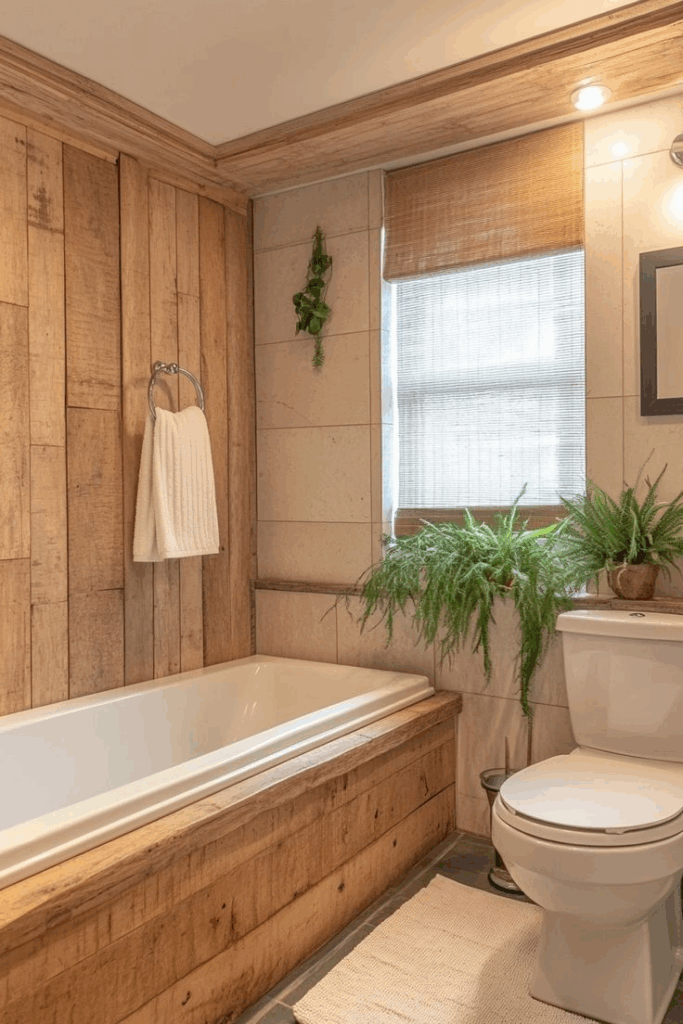
Floor-to-ceiling wood paneling transforms any ordinary bathroom into a warm, spa-inspired escape. By wrapping the space in natural tones and textural richness, it adds a sense of grounded calm ideal for self-care routines. Vertical paneling can draw the eye upward, making compact spaces appear taller, while horizontal layouts help elongate narrow rooms. Choosing moisture-resistant hardwoods such as teak, cedar, or engineered wood with sealed finishes ensures durability in high-humidity environments. For a refined touch, pairing matte-finished panels with warm lighting introduces softness without overpowering the room. This design technique also allows seamless integration with concealed cabinetry, built-in towel racks, or shelving—keeping clutter minimal and design integrity intact. It’s especially effective when paired with matte black or brushed brass fixtures, allowing the wood’s natural grain to remain the visual anchor. Maintenance is low with proper sealing and ventilation, and the result is a bathroom that feels both grounded and elegant. Whether styled rustic or modern, full paneling delivers character and cohesion throughout. Interest continues to grow across design platforms for wood-wrapped bathrooms that blend comfort with craftsmanship. For those looking to replace sterile white tiles with something more tactile, this approach feels like the perfect evolution of warmth-meets-utility design.
Live-Edge Wood Vanities
Live-edge vanities turn functional fixtures into sculptural showpieces, bringing an organic element few materials can match. With their raw, uncut contours, these slabs honor the natural lines of the tree they came from, offering a one-of-a-kind silhouette that feels rooted in artistry. Teak and walnut are common choices due to their moisture resistance and visual depth. When paired with a vessel sink or minimalist hardware, the irregular edge draws immediate focus without overwhelming the room. Each vanity becomes a storytelling piece, ideal for bathrooms where design details matter as much as functionality. To protect against water damage, high-quality epoxy resin or oil-based finishes seal the grain while maintaining its character. A floating mount further highlights the sculptural beauty while increasing visible floor space, perfect for smaller bathrooms. Pairing with contrasting textures—such as concrete floors or matte tiles—amplifies the vanity’s warmth. This design detail is gaining popularity across interior design social channels as users look for earthy statements that still feel upscale. If seeking a bold, natural anchor for a refined bathroom aesthetic, the live-edge vanity delivers both in form and function. No two are ever alike, which adds to the vanity’s visual intrigue and long-lasting appeal.
Wood Slat Walls
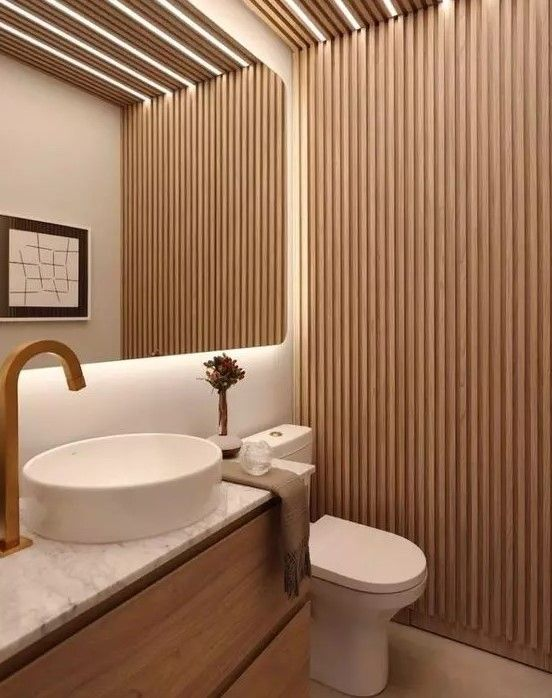
Linear wood slats introduce movement and rhythm into the bathroom without overwhelming the senses. Typically applied as accent walls behind vanities, mirrors, or bathtubs, slatted designs add architectural depth and a tactile quality that smooth surfaces lack. The slight spacing between each slat allows subtle shadows to play across the wall, offering dynamic visuals throughout the day. Cedar, teak, and thermally treated ash are favored for their natural resistance to moisture, making them reliable choices for wet zones. Whether finished in a rich walnut stain or kept light and unfinished for a Scandinavian feel, wood slats can be customized to complement any style direction. For modern bathrooms, pairing them with oversized tiles or sleek stone sinks enhances contrast while maintaining cohesion. Design-forward homeowners often use backlighting or recessed lighting to accentuate the vertical lines and elevate the room’s atmosphere. Maintenance is straightforward with sealed finishes and regular dusting. With their versatility and visual refinement, slatted walls are showing up frequently in curated bathroom designs on Pinterest and Instagram. Their appeal lies in their simplicity—managing to feel timeless, earthy, and design-driven all at once. It’s a minimalist upgrade that introduces warmth without sacrificing the clean lines many homeowners crave.
Reclaimed Wood Accents
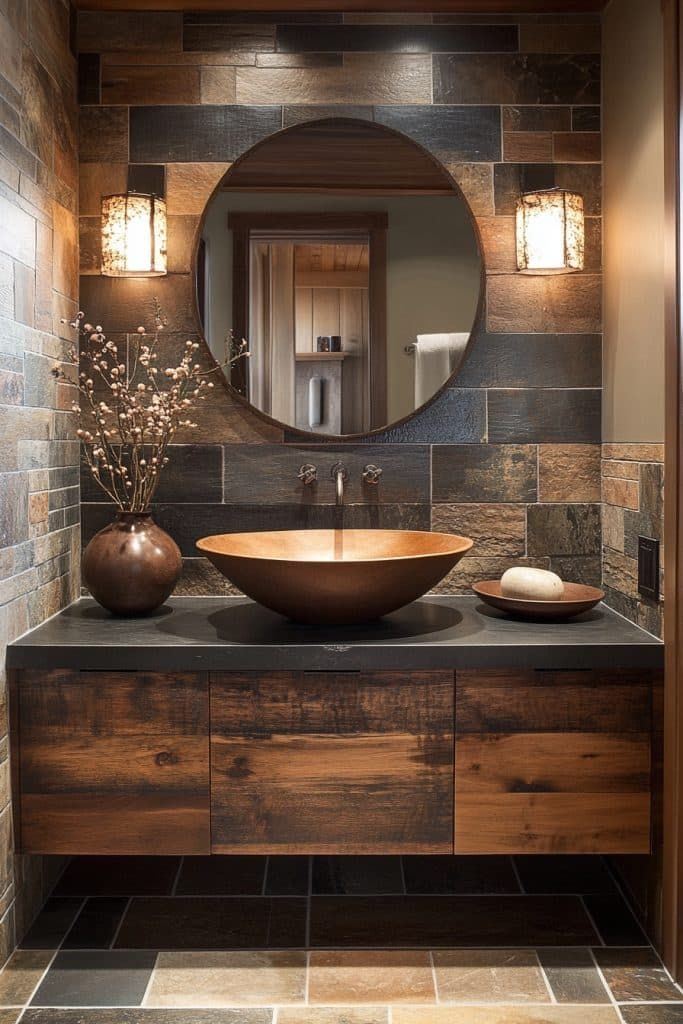
Designers are increasingly turning to reclaimed wood to bring authenticity and sustainability into bathroom spaces. Whether used for vanities, shelving, mirror frames, or accent walls, reclaimed timber delivers character-rich textures no manufactured product can match. Each plank bears its own story, with natural imperfections, patina, and grain variations that make it a standout design element. Hardwoods like oak, chestnut, or barn wood are ideal since they’re durable and able to withstand humid conditions once properly sealed. When integrated thoughtfully, reclaimed wood contrasts beautifully with modern materials—like polished stone countertops or frameless glass—striking a balance between old-world charm and contemporary sleekness. For homeowners committed to eco-conscious choices, repurposing existing wood reduces waste while introducing material richness. Even small touches, like reclaimed towel racks or custom cabinetry, can shift the room’s energy toward something more inviting and rooted. Trending styles often pair reclaimed wood with industrial accents—such as matte black hardware or exposed plumbing—to add grit and edge. Each installation carries a sense of heritage and sustainability, two qualities increasingly valued in design-forward households. As more people seek ways to personalize their spaces meaningfully, reclaimed wood continues to lead the charge with warmth, narrative, and style.
Wood and Stone Combinations
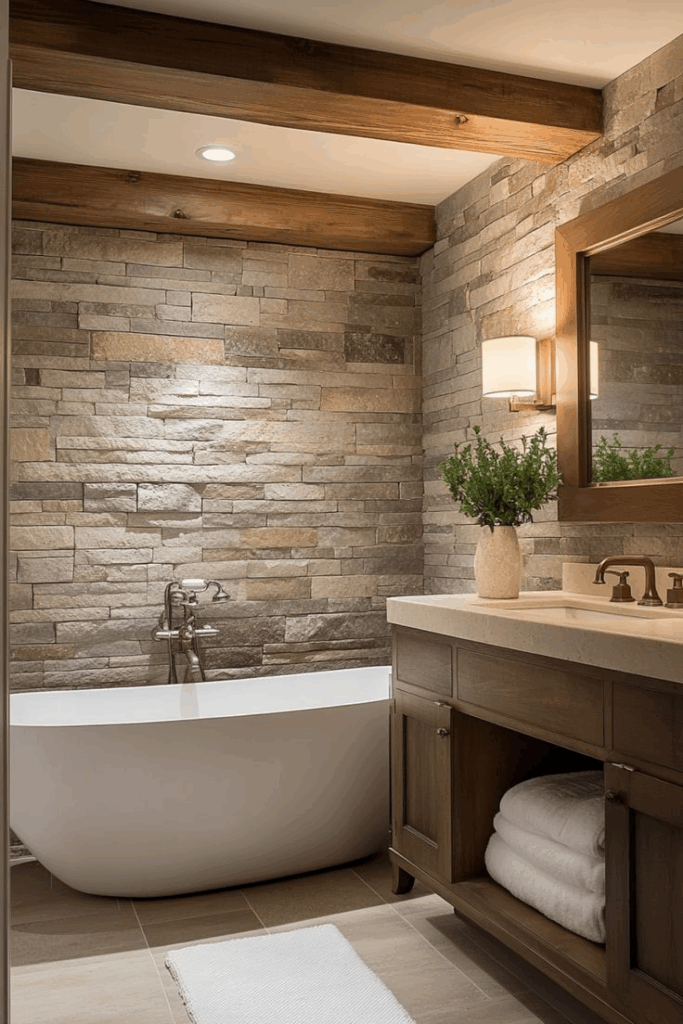
Pairing wood and stone in a bathroom delivers tactile contrast and grounded luxury. This duo balances visual warmth with rugged texture, often seen in spa-style interiors that embrace nature as the core design inspiration. Think stone basin sinks resting on oak counters or pebble-tiled shower floors surrounded by wooden bench seating. When done correctly, this mix feels elemental and restorative. Key to success is choosing finishes that complement rather than compete—lightwashed wood pairs well with matte marble or travertine, while darker wood tones sit beautifully beside honed slate or soapstone. The textural interplay draws interest while maintaining cohesion. Moisture resistance remains critical, so sealing both surfaces ensures longevity without sacrificing appearance. Whether you’re after a rustic-luxe ambiance or a minimalist organic vibe, this pairing adapts seamlessly to different aesthetics. Homeowners increasingly favor this combination for its grounding qualities, as evidenced by its popularity in high-end design portfolios and spa renovations. Integrated lighting and greenery further enhance the sense of tranquility. This method is especially powerful in master bathrooms, where relaxation and form are priorities. Wood and stone combinations are more than a design trend—they’re a lasting testament to nature’s ability to offer beauty and balance when thoughtfully composed.
Dark Wood Finishes
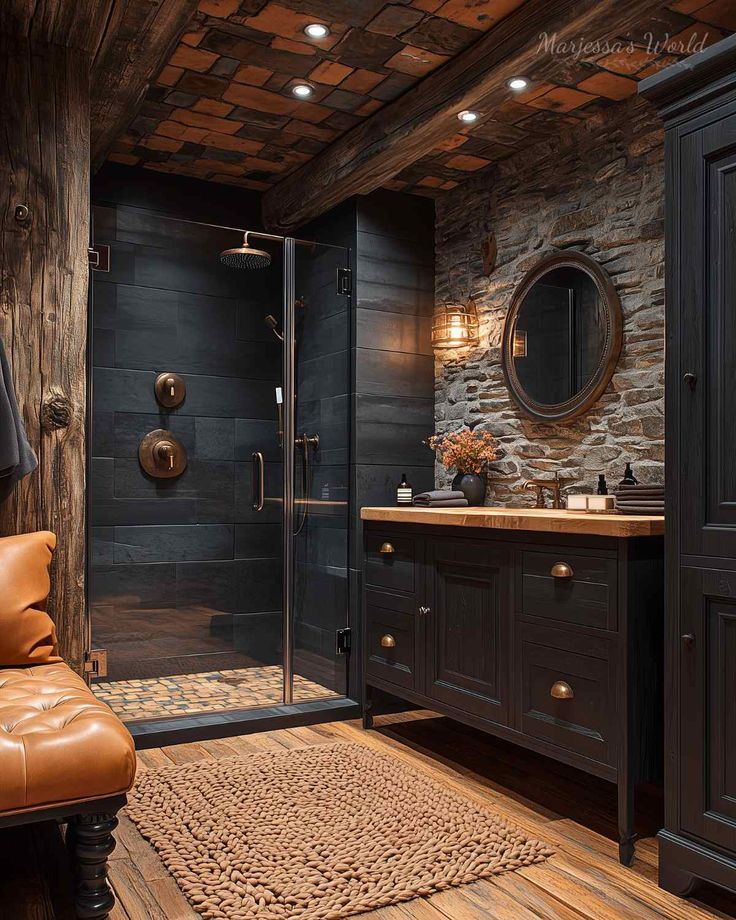
Deep wood tones are gaining momentum in bathroom interiors, offering a bold yet refined alternative to lighter palettes. Whether seen in vanities, paneling, or cabinetry, shades like espresso, walnut, and mahogany bring depth, drama, and timeless elegance to the space. These tones work particularly well in bathrooms aiming for a moody or masculine vibe, providing visual weight and richness without overwhelming. When set against crisp white countertops or brushed gold hardware, the contrast creates instant sophistication. High-gloss finishes can add a sense of modernity, while matte textures lean more traditional and grounded. For smaller bathrooms, strategic lighting is essential to keep the room from feeling enclosed—recessed fixtures or backlit mirrors can effectively counterbalance the richness. Popular across Pinterest boards for luxury interiors, dark wood adds a touch of indulgence that many associate with boutique hotels or high-end spas. Proper sealing ensures durability in wet areas, especially for cabinetry exposed to frequent moisture. Pairing dark wood with materials like marble, stone, or glass keeps the palette from feeling too heavy. With increasing interest in bathroom designs that feel private and elevated, dark wood finishes are proving to be a sophisticated solution that combines atmosphere with timeless style.
Floating Wood Shelves

Wall-mounted wooden shelves offer both function and flair, especially in bathrooms that need smart storage without bulk. Their open design allows easy access to essentials while maintaining a clean, airy aesthetic. Ideal for small to mid-sized spaces, floating shelves can hold everything from rolled towels to skincare jars, framed art, or decorative candles. Depending on the finish—natural, stained, or painted—they fit seamlessly into a variety of decor styles, from rustic to Scandinavian to modern farmhouse. Popular wood choices include pine for its affordability, oak for its durability, and walnut for its luxe grain pattern. To ensure safety in humid environments, anchoring shelves into wall studs and using water-resistant sealing treatments is non-negotiable. For visual harmony, matching shelf tones with the vanity or mirror frame strengthens cohesion in the overall design. Floating wood shelves have become Pinterest favorites for bathroom styling, especially when paired with minimalist brackets or concealed hardware. They allow for flexible customization—you can stack them vertically, align asymmetrically, or install just one as a feature. Their growing appeal lies in their balance of simplicity and purpose. When designed well, they offer easy access, visual warmth, and a personal touch without overwhelming the space.
Wood-Framed Mirrors
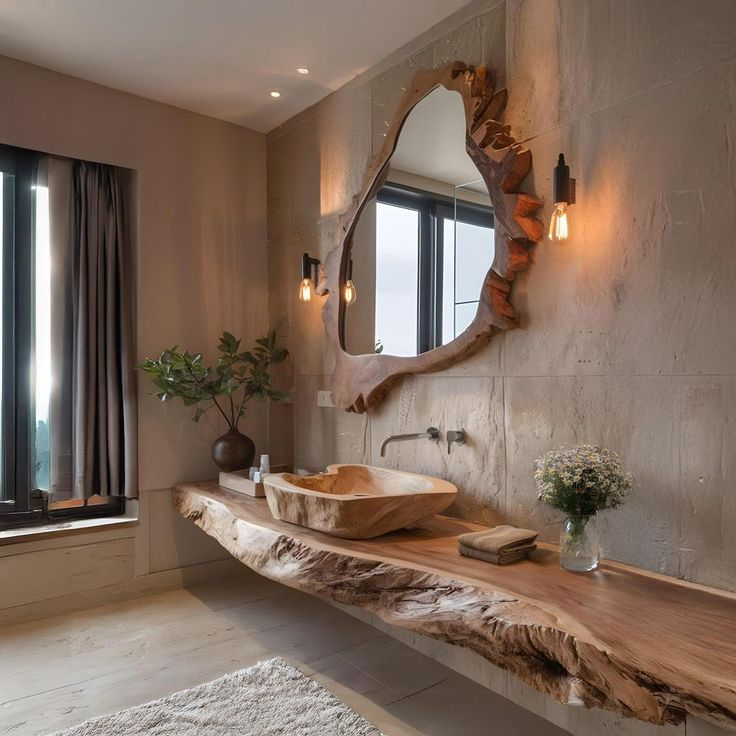
Mirror framing offers an easy yet impactful way to introduce natural warmth into a bathroom. Wood-framed mirrors, in particular, blend practicality with beauty, serving both functional and decorative purposes. Whether styled sleek and modern with slim teak borders or rustic with reclaimed barn wood, these mirrors complement nearly any design approach. Frames crafted from oak, walnut, or cedar provide durable elegance and moisture resistance with the right sealants. The grain patterns add organic texture, breaking up sterile tiles or painted walls with something more visually grounded. They can be mounted above vanities, leaned against the wall, or even backlit for added atmosphere. Popular pairings include matte black faucets, minimalist sconces, or statement lighting to amplify their charm. This feature works well in both compact powder rooms and expansive primary baths. Wood-framed mirrors are especially appealing for their affordability and versatility—offering a transformative upgrade without major renovation. Often found in Instagram home styling posts, these mirrors anchor the space with character. They work particularly well when echoed in other elements like shelving, cabinetry, or flooring. Whether you want contrast or coordination, wood-framed mirrors deliver a blend of rustic charm and refined polish that resonates across styles.
Wooden Bathtubs
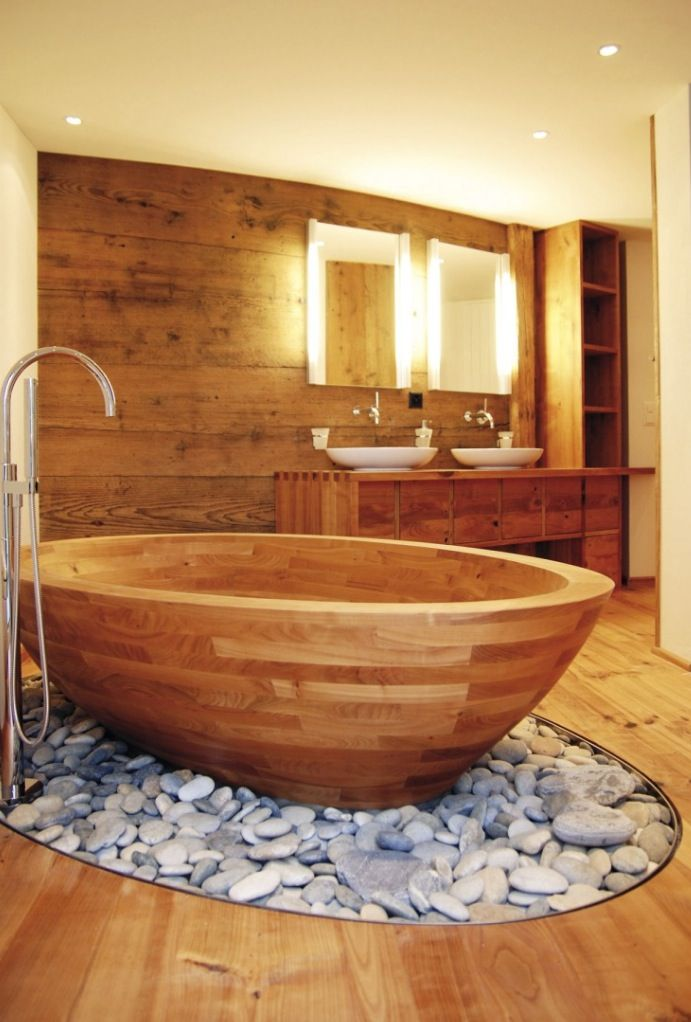
Custom wooden bathtubs are a statement of luxury craftsmanship, instantly drawing attention with their sculptural beauty and artisanal appeal. Typically made from teak, hinoki, or cedar due to their natural water resistance and anti-fungal properties, these tubs are expertly sealed using marine-grade finishes to prevent moisture damage. Their thermal properties also retain heat longer than traditional materials, making soaks more indulgent. The warm tone of wood contrasts beautifully with cold surfaces like stone tiles or metal fixtures, offering a balanced, spa-like aesthetic. Often seen in Japanese-inspired designs, wooden tubs encourage relaxation through both visual warmth and physical comfort. Customization options range from freestanding oval forms to deeper soaking varieties, with options for integrated seating or asymmetrical shapes. While they require more upkeep—regular drying and resealing—they’re prized for their durability and longevity when cared for properly. Wooden bathtubs have gained traction on high-end renovation platforms and design showcases for their rare blend of function and sculpture. They don’t just serve a purpose; they define the space. For homeowners looking to move beyond traditional porcelain, a handcrafted wooden tub becomes the focal point of serenity and style in the bathroom—a luxury choice that reflects taste, wellness, and artisan values.
Wood-Look Tiles

Modern tile manufacturing makes it possible to enjoy the appearance of wood with the durability of ceramic or porcelain. Wood-look tiles are perfect for bathrooms where moisture exposure makes real wood impractical. These tiles convincingly mimic everything from rustic oak to polished walnut, complete with grain patterns and matte finishes. Available in plank or herringbone styles, they allow flexibility in design without compromising on practicality. Slip-resistant finishes and stain-proof surfaces make them ideal for high-traffic bathrooms or households with kids. Unlike natural wood, these tiles won’t warp or fade over time, and they’re effortless to maintain—requiring only basic cleaning with no need for sealing or polishing. Radiant floor heating systems also work well with tile, offering comfort underfoot. Trending styles include pairing these tiles with minimalist white vanities or matte black fixtures for modern contrast. Wood-look tiles provide a timeless, nature-inspired foundation while remaining budget-friendly and highly durable. For those who want the warm aesthetic of wood but need a waterproof, low-maintenance solution, this hybrid is a practical favorite. Popular across home renovation accounts and Pinterest boards, they deliver style, texture, and longevity in one affordable and versatile package—perfect for modern bathrooms of all sizes.
Wooden Ceiling Beams
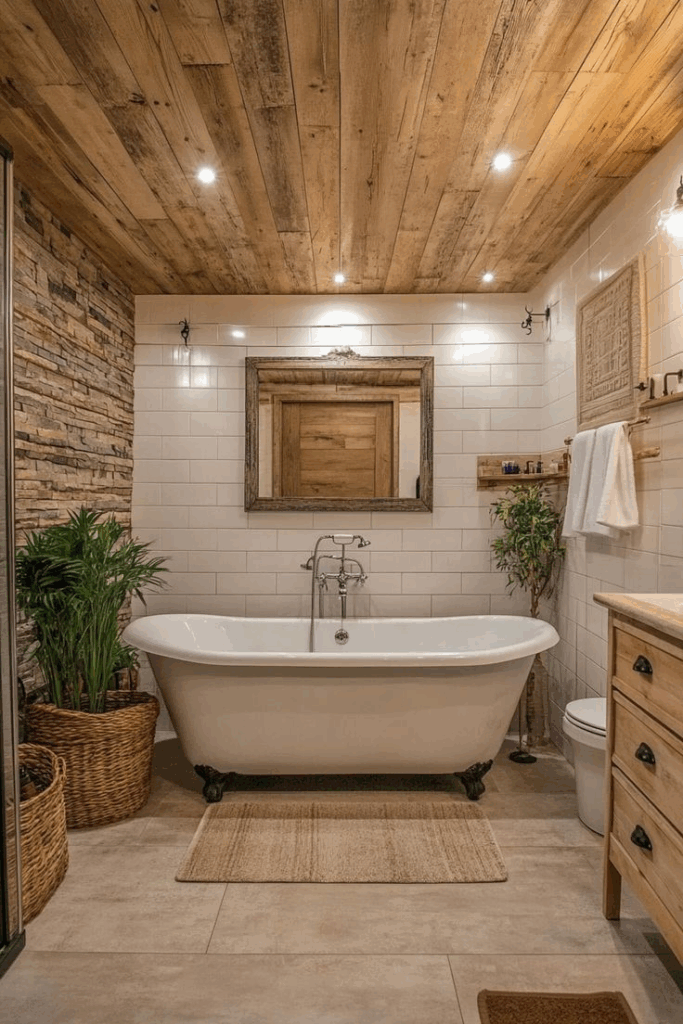
Ceiling beams introduce architectural interest to bathrooms, especially when paired with vaulted or high ceilings. Exposed wooden beams—whether structural or decorative—draw the eye upward and frame the space with rustic or farmhouse charm. Oak, Douglas fir, or reclaimed wood are popular choices due to their strength and aesthetic richness. Finished in natural tones or whitewashed for a coastal feel, beams help soften sterile surfaces like tile or concrete. Even in smaller bathrooms, faux wood beams offer the same visual effect without the weight or structural demands of real timber. They can be used singularly for subtle detail or in series to emphasize symmetry and depth. This feature pairs well with natural light, skylights, or open-concept layouts to maintain an airy feel. Design professionals often use them to echo other wooden elements in the room, such as vanities or flooring, ensuring cohesion throughout. Wood beams are increasingly found in boutique spa designs and high-end remodels, where architectural character plays a lead role. With proper sealing and ventilation, maintenance remains minimal. Whether rustic or refined, ceiling beams introduce warmth, craftsmanship, and dimension—elevating the bathroom beyond a purely functional space into a more thoughtfully curated retreat.
Wooden Storage Solutions
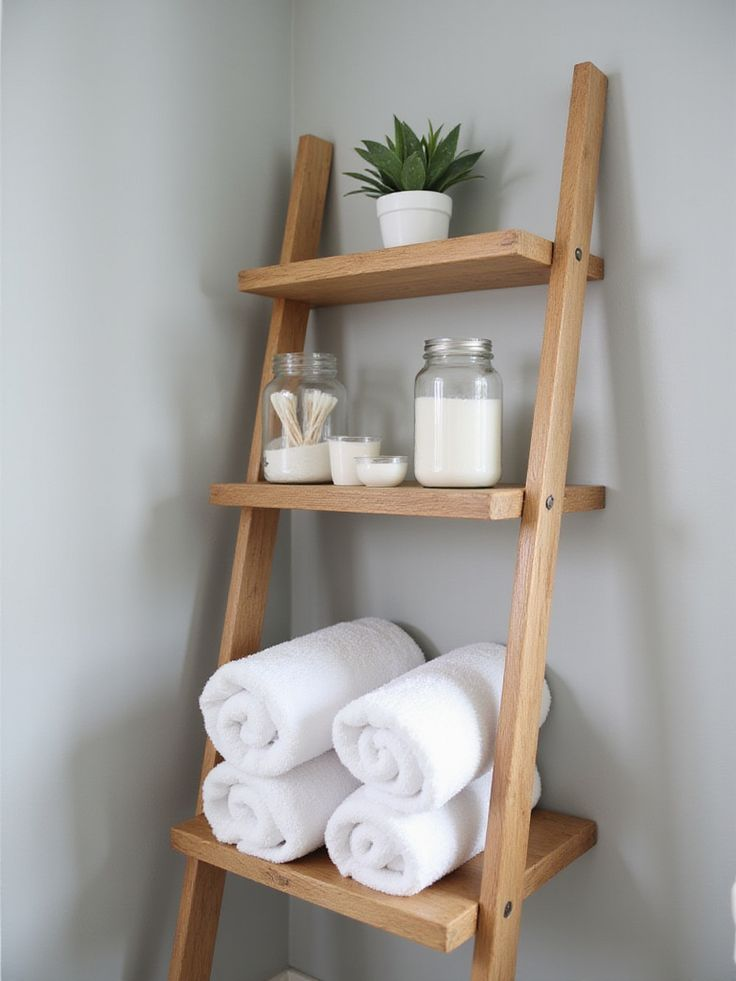
Integrated wood storage brings structure and serenity to bathroom organization. From open shelving units to custom cabinetry, wood adds a tactile quality that elevates even the most utilitarian elements. Birch, maple, and oak are commonly used for their strength and resistance to moisture when properly sealed. Drawers, cubbies, and concealed compartments crafted from these materials offer both aesthetic consistency and practical utility. Floating wood cabinets can make smaller bathrooms feel larger, while tall vertical units utilize unused wall space without visual clutter. In open designs, storage baskets, linen organizers, and folded towel displays look more curated when framed in wood tones. The key is using stain or varnish treatments to match existing elements like vanities, mirrors, or flooring. Increasingly, homeowners are leaning into hidden storage—drawer organizers, under-sink pullouts, or recessed niches—to keep toiletries out of sight while maintaining the room’s elegance. Pinterest trends reveal strong interest in these setups, particularly those that strike a balance between display and discretion. Matching wood tones throughout ensures harmony while allowing flexibility in form and layout. As demand grows for bathrooms that are both calming and clutter-free, wood storage solutions deliver clean lines and comforting textures in one seamless design element.
Wood and Glass Partitions
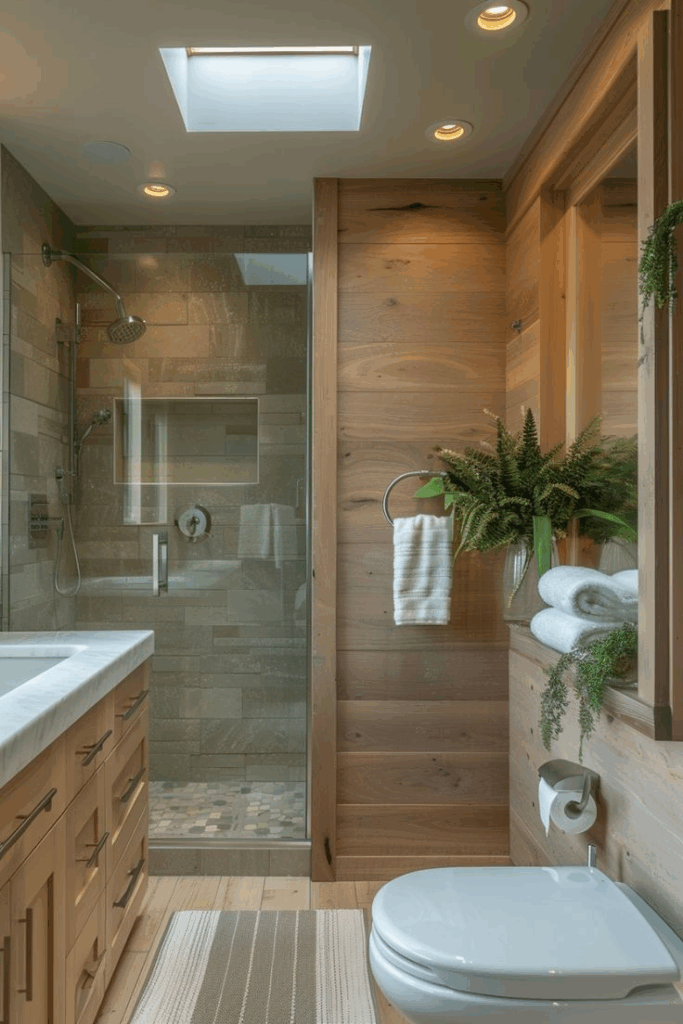
Partitioning with wood and glass offers privacy without closing off the space. This combination is perfect for shared bathrooms, en-suites, or open-concept designs where division is needed but visual openness must be preserved. Wooden frames—often in walnut or white oak—pair with frosted, ribbed, or clear glass panels to define areas like showers, toilets, or dressing zones. These partitions provide structure while still allowing light to flow, preserving the room’s brightness. Frameless glass often feels too modern or sterile, while pure wood may feel too dense—together, they strike a visually balanced middle ground. Reeding or fluting in the glass adds an extra layer of texture and privacy without compromising style. Hinged or sliding models are popular for their flexibility, and wall-mounted variants reduce floor clutter. From a functional standpoint, these structures withstand humidity and require minimal maintenance with quality sealants and finishes. As open-concept living evolves, bathrooms are following suit, incorporating multi-functional zones within a single footprint. Wood and glass partitions support that trend with subtle elegance. Their rising presence in design blogs and real estate showrooms speaks to their long-term appeal. This architectural feature offers both separation and cohesion—perfect for those seeking design flexibility and timeless sophistication.
Wooden Flooring

Hardwood flooring in the bathroom requires careful consideration, but the payoff is a luxurious, cohesive look that extends natural warmth across the space. Engineered wood is often the go-to choice—it provides the aesthetic of solid hardwood with improved moisture resistance due to its layered construction. Species like white oak, teak, and acacia stand up well to humidity when sealed with polyurethane or aluminum oxide finishes. These floors bring continuity to homes where wood runs through adjacent bedrooms or hallways, eliminating visual breaks and adding resale value. Warm tones underfoot offset the chilliness of stone or tile, making the space feel more inviting. When used with radiant floor heating, wooden floors become even more comfortable. Homeowners should ensure adequate ventilation and avoid excess water pooling to preserve the finish. Light distressing or hand-scraped textures can help disguise wear over time. Many bathroom remodels now include wide-plank wood flooring as a premium upgrade, signaling both style and comfort. Trending heavily across Pinterest and design publications, wood floors offer timeless appeal that bridges rustic and modern aesthetics. For those ready to invest in both elegance and practicality, wood flooring delivers an organic foundation that supports both style and everyday functionality.
Wooden Accessories
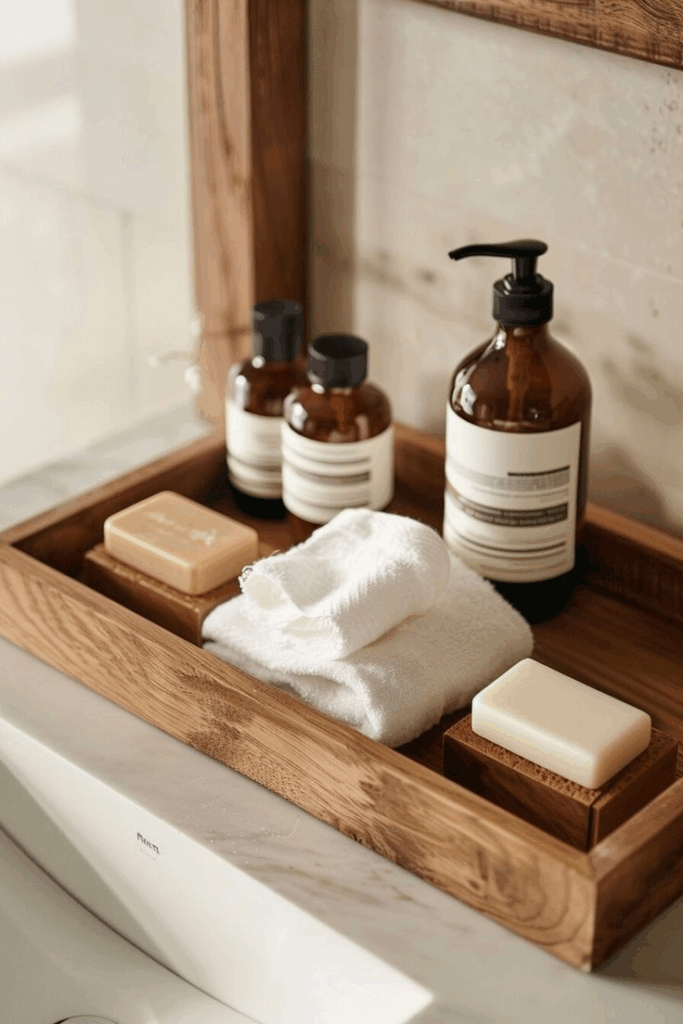
Thoughtful accessorizing can significantly enhance a bathroom’s ambiance, and wooden accents offer a subtle yet powerful way to tie the room together. From soap trays and toothbrush holders to towel ladders and bath trays, these pieces layer warmth into sterile settings without dominating the aesthetic. Bamboo is particularly popular for its lightweight, sustainable nature, while teak and acacia offer richer tones and longer durability. Using these items throughout the space helps create cohesion between larger wooden features like vanities or shelving. Look for items with water-resistant coatings to prolong usability and prevent mildew. Many homeowners opt for custom or handmade wooden accessories for a personalized touch that feels intentional. Compact bathrooms especially benefit from coordinated accents that keep the palette grounded without crowding surfaces. These accessories also serve functional purposes—such as organizing daily essentials—while maintaining a calm, styled appearance. Their affordability and availability make them an accessible upgrade for those not ready to commit to large-scale wood installations. Popular across home decor platforms, wooden accessories consistently rank high in curated bathroom design checklists. When selected with care, they add soul to the space and encourage a harmonious balance between function, design, and nature’s quiet elegance.
